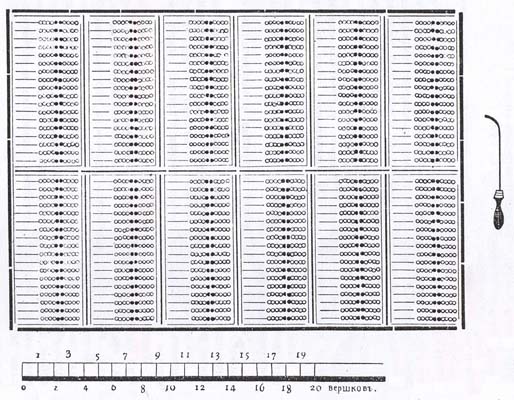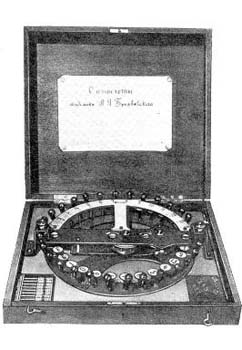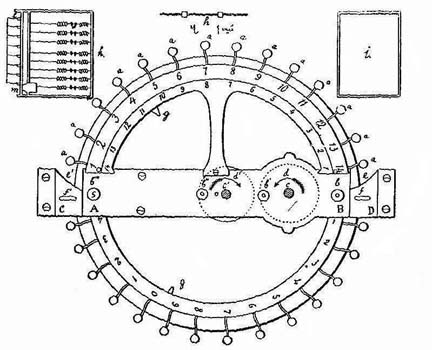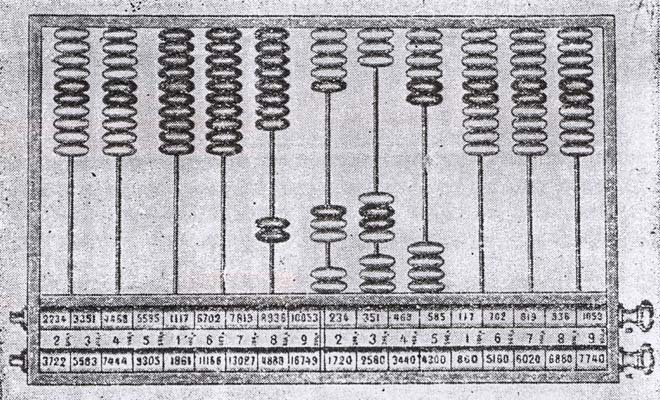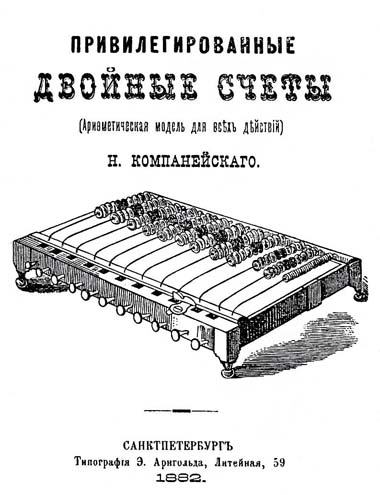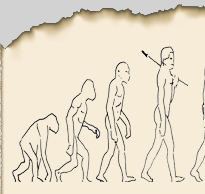


|
There was a strong need in a convenient calculation device from the beginning of the 19th century. For a hundred years up to the beginning of the mass spread of arihtmometers a lot of modifications for stchoty were suggested in Russia.
The first mention of them appeared in 1815, when an article about "newly invented stchoty" was published in a “Syn Otechestva” (The son of motherland) magazine. An anonymous author insisted that a new method of multiplication and division executing was proposed, which took only two minutes to multiply two seven-digit numbers. Unfortunately, no further information was given. In 1828 the stchoty of major-general F. M. Svobodskoi appeared and caused a great sensation. Svobodskoi calculation device consisted of several joined identical stchoty (three and more). The inventor himself recommended to use a combination of 12 stchoty, but sometimes he used 30 stchoty at once! Stchoty were placed in one or two rows in a special frame, which was set on a desk or on a special platform. Each stchoty had 18 rows. A specially curved stick with a handle was used to move beams. Svobodskoi method had a rather high calculation speed (five or six times as fast as calculation with pen and paper). Next year Svobodskoi method was introduced into curriculum of all Russian universities. Several manuals and textbooks were published, but soon after inventor's death the interest came to naught.
In 1861 Ivan Burakov suggested to use stchoty with 21 rows. In 1867 academician V. Ja. Bunyakovsky invented an original but rather very simple key-driven adding device – Samostchoty (self-counting stchoty). It was possible to input numbers to Samostchoty from 1 to 14 only, so small stchoty were used to add and memorize intermediate sums. In 1876 Bunyakovsky redesigned his Samostchoty. The new device – Uluchshennye Samostchoty (Improved Samostchoty) looked like a rotating brass disk set up on the wooden board, and static metal ring with drawn numbers from 1 to 99 (maximum sum is equal to 10,000). The size of the device is 24,5x21x0,7 cm. Two survived of these devices are kept now in Petrozavodsk (Karelia) and in Polytechnical Museum in Moscow.
In 1872 F. V. Ezersky suggested his “stchoty with device for multiplication and division”. His stchoty had vertical rows with long side placed to a counting man. Two rotating rollers were placed along a lower slat. Canvas printed rows with digits was wound on these rollers. The rows with digits looked like multiplication table form two to nine. There was one more distinctive feature: Ezersky stchoty had a special coloured beams in some groups of rows. Ezersky has patented his stchoty in several countries, including the USA (patent # 144523, November 11th, 1873).
In 1882 N. I. Kompaneisky published the description of his so-called “privileged double stchoty”. His stchoty also were used only to sum final calculation results on rollers with numbers. The rows of Kompaneisky stchoty were placed not inside a frame, but over the desk, and covered rollers inside the frame. The board with stchoty could move along sledges up and down, right (to the end of rollers), and return to the left border of the frame without its crossing. A small window was opposite each row on the left side of the cover. The digits on rollers with a required number were set in these windows before any operations. Special buttons in the left part of the frame were used to rotate rollers. Rollers had springs, fixed them in the necessary position.
The main idea of the device was the following: depending on the required operation some movements of the cover were made while new rows of digits appeared in small windows. They were temporary results to sum or to reset. In 1896 Vladimir Georgievich von Bool’ (1835-1899), a famous Russian teacher and scientist, suggested his own stchoty. They consisted of common Russian stchoty connected with the second one having 12-14 rows with 10 beams each. The frame had numbered rows and a narrow slate board down along the schoty. Though none of these projects was a success, attempts to create a universal counting device did not ceased. B. N. Kompaneisky suggested to combine stchoty with the multiplication table in 1921. “The invention of B. N. Kompaneisky can replace arithmometers successfully” – it was written in the protocol of one of the Technical Sessions of Russian government. This invention has been used for several years, but at all Kompaneisky stchoty didn’t withstand competition with arithmometers. And it was the last known attempt to upgrade Russian stchoty. Arithmometers defeated them finally. But the common stchoty were still used almost around all Russia. Only during last 20 years Russian stchoty came out of use because pocket calculators. It is impossible to see them now neither in big cities nor in small villages. So references that stchoty is still used – is a myth, like walking bears in the Red Square in Moscow. |





